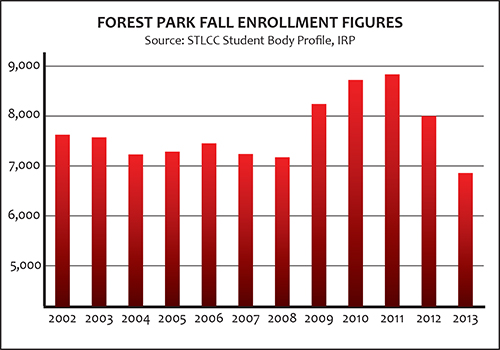 By Chris Cunningham
By Chris Cunningham
and Julian Hadley
The Scene staff
Forest Park enrollment has dropped 15 percent from last fall — from 7,994 to 6,815 students — continuing a downward trend that started two years ago.
President Cindy Hess believes there are multiple reasons.
“We’d like to think the economy is improving and there are more people finding full- and part-time work,” she said.
In addition, Hess cites a national drop in college enrollment and retention, and stricter guidelines for financial aid dispersal.
“We expect for students to get here, sign up for a major and complete that major,” she said. “We will no longer let them stay and change majors to the degree they were allowed to in the past.”
Fall enrollment at Forest Park increased dramatically from 2008 to 2009, going from 7,164 to 8,210 students. The upward trend continued in 2010 and 2011 before falling from 8,823 to 7,994 students in 2012.
In the past two years, drops have caused class cancellations, forcing students to scramble to find new classes at the last minute.
This happened to health information technology major Melanie Sherman, 24, last semester.
“I only got to take four credit hours out of the 12 I enrolled for,” she said.
Terrance Lynch, 24, another health information technology major, was enrolled in two classes that were canceled this semester.
He’s concerned that classes dropped this semester will be overloaded in the spring.
“Not only will we be competing with those who planned to take the classes in the spring, but also those who couldn’t take them in the fall,” he said.
Like Hess, Vice President of Student Affairs Thomas Walker thinks enrollment drops can be partly attributed to low retention levels.
That’s why he has placed a high priority on programs that help students stay in school.
“When returning students have access to services which assist in the successful completion of their degree programs, much of the work in maintaining a strong student body is already done,” Walker said.
The college also is trying to make the enrollment process simpler.
One way, Hess said, is to train employees to handle multiple situations without sending students to different offices. Another is to consolidate student resources, such as financial aid and advising, which is being done as part of the Student Center renovation.
“When enrollment is complicated, it requires multiple visits to campus and seeing multiple people, who may or may not give (students) the correct information,” Hess said. “That’s a stress we don’t want to tolerate anymore.”
The college also is trying to help students graduate faster, by combining remedial and college-level classes. Required classes are being developed to provide students with material that directly relates to their majors.
“If students test into developmental reading, we ought to include reading materials that match their major,” Hess said. “Because then, they can see the connection, and they are probably going to be more engaged.”
